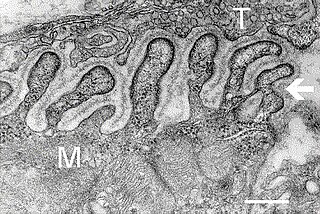
An acetylcholine receptor is an integral membrane protein that responds to the binding of acetylcholine, a neurotransmitter.

A neuromuscular junction is a chemical synapse between a motor neuron and a muscle fiber.

Nicotinic acetylcholine receptors, or nAChRs, are receptor polypeptides that respond to the neurotransmitter acetylcholine. Nicotinic receptors also respond to drugs such as the agonist nicotine. They are found in the central and peripheral nervous system, muscle, and many other tissues of many organisms. At the neuromuscular junction they are the primary receptor in muscle for motor nerve-muscle communication that controls muscle contraction. In the peripheral nervous system: (1) they transmit outgoing signals from the presynaptic to the postsynaptic cells within the sympathetic and parasympathetic nervous system, and (2) they are the receptors found on skeletal muscle that receive acetylcholine released to signal for muscular contraction. In the immune system, nAChRs regulate inflammatory processes and signal through distinct intracellular pathways. In insects, the cholinergic system is limited to the central nervous system.

Agrin is a large proteoglycan whose best-characterised role is in the development of the neuromuscular junction during embryogenesis. Agrin is named based on its involvement in the aggregation of acetylcholine receptors during synaptogenesis. In humans, this protein is encoded by the AGRN gene.
Dok-7 is a non-catalytic cytoplasmic adaptor protein that is expressed specifically in muscle and is essential for the formation of neuromuscular synapses. Further, Dok-7 contains pleckstrin homology (PH) and phosphotyrosine-binding (PTB) domains that are critical for Dok-7 function. Finally, mutations in Dok-7 are commonly found in patients with limb-girdle congenital myasthenia.
Congenital myasthenic syndrome (CMS) is an inherited neuromuscular disorder caused by defects of several types at the neuromuscular junction. The effects of the disease are similar to Lambert-Eaton Syndrome and myasthenia gravis, the difference being that CMS is not an autoimmune disorder. There are only 600 known family cases of this disorder and it is estimated that its overall frequency in the human population is 1 in 200,000.

43 kDa receptor-associated protein of the synapse (rapsyn) is a protein that in humans is encoded by the RAPSN gene.

Neuronal acetylcholine receptor subunit alpha-7, also known as nAChRα7, is a protein that in humans is encoded by the CHRNA7 gene. The protein encoded by this gene is a subunit of certain nicotinic acetylcholine receptors (nAchR).

Neuronal acetylcholine receptor subunit alpha-4, also known as nAChRα4, is a protein that in humans is encoded by the CHRNA4 gene. The protein encoded by this gene is a subunit of certain nicotinic acetylcholine receptors (nAChR). Alpha4-containing nAChRs appear to play a crucial role in the addictive response to nicotine.

Neuronal acetylcholine receptor subunit beta-2 is a protein that in humans is encoded by the CHRNB2 gene.

Neuronal acetylcholine receptor subunit alpha-3, also known as nAChRα3, is a protein that in humans is encoded by the CHRNA3 gene. The protein encoded by this gene is a subunit of certain nicotinic acetylcholine receptors (nAchR). Research with mecamylamine in animals has implicated alpha-3-containing nAChRs in the abusive and addictive properties of ethanol.

Neuronal acetylcholine receptor subunit alpha-1, also known as nAChRα1, is a protein that in humans is encoded by the CHRNA1 gene. The protein encoded by this gene is a subunit of certain nicotinic acetylcholine receptors (nAchR).

Neuronal acetylcholine receptor subunit beta-4 is a protein that in humans is encoded by the CHRNB4 gene.

Acetylcholinesterase collagenic tail peptide also known as AChE Q subunit, acetylcholinesterase-associated collagen, or ColQ is the collagen-tail subunit of acetylcholinesterase found in the neuromuscular junction. In humans it is encoded by the COLQ gene.

Neuronal acetylcholine receptor subunit beta-3 is a protein that in humans is encoded by the CHRNB3 gene. This gene has been identified as a candidate for predisposition to tobacco dependence.

Neuronal acetylcholine receptor subunit alpha-2, also known as nAChRα2, is a protein that in humans is encoded by the CHRNA2 gene. The protein encoded by this gene is a subunit of certain nicotinic acetylcholine receptors (nAchR).

Acetylcholine receptor subunit delta is a protein that in humans is encoded by the CHRND gene.

Acetylcholine receptor subunit gamma is a protein that in humans is encoded by the CHRNG gene.

Acetylcholine receptor subunit beta is a protein that in humans is encoded by the CHRNB1 gene.

Cholinergic receptor, nicotinic, alpha 6, also known as nAChRα6, is a protein that in humans is encoded by the CHRNA6 gene. The CHRNA6 gene codes for the α6 nicotinic receptor subunit that is found in certain types of nicotinic acetylcholine receptors found primarily in the brain. Neural nicotinic acetylcholine receptors containing α6 subunits are expressed on dopamine-releasing neurons in the midbrain, and dopamine release following activation of these neurons is thought to be involved in the addictive properties of nicotine. Due to their selective localisation on dopaminergic neurons, α6-containing nACh receptors have also been suggested as a possible therapeutic target for the treatment of Parkinson's disease. In addition to nicotine, research in animals has implicated alpha-6-containing nAChRs in the abusive and addictive properties of ethanol, with mecamylamine demonstrating a potent ability to block these properties.

















